[ed. note: this post follows up on Libby’s post about our trip to Baltimore to see the American Visionary Art Museum.]
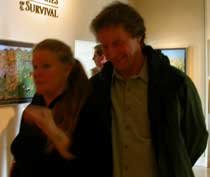
When we got out of the car in Baltimore at AVAM, Libby and I found out that Baltimore is the city of brotherly hugs. Our host, Mark Barry, warned us about it when he greeted us with a hug. Every time thereafter when a hug came our way — and they kept coming as introductions were made inside AVAM, he looked over and said “See.” (top image is a couple of the Baltimore huggers, Mark Barry, AVAM board member, artist and blogger, r, and Rebecca Hoffberger, Founder and Director of AVAM, l. The two are standing in one of AVAM’s six gallery spaces)
Even without the hugs the day trip would have been a high.
“I’m interested in fresh thought,” Hoffberger said to me when I asked her how she got interested in folk art. She had bristled at my use of the term “folk art.” She doesn’t like the term at all and prefers visionary.
In my press kit was a page defining visionary art. It explains the difference between “folk art” and visionary art and made me understand Hoffberger’s distinction.
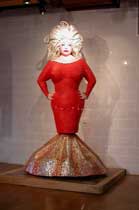
Quoting:
“Although there is a kinship with folk art, in that both tend to be made by everyday ‘folk” or people, we define folk art as art-making traditions that are learned at the knee, or by familiarization with an art tradition of a specific ethnic or geographic group (i.e., Amish quiltmakers, Hopi Kachina dolls, even colonial portraiture)….Visionary artists are self-taught, intuitive people who find their own way into the making of art in an intensely personal way. Visionary art dances on the edge.” (image is movie star, Divine, a Baltimorian and maybe possibly not a hugger, memorialized as a statue at AVAM.)
The Rouse Center
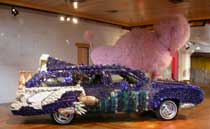
Hoffberger went on to say visionary thought could be a new melody, a scientific advance, or even social policy. One of the AVAM outbuildings, (there are three altogether laid out on a kind of campus), the James Rouse Visionary Center which opened in 2004, is dedicated to the late local developer whom Hoffberger considers a social visionary. (The Center, which includes classrooms, a sculpture hall and banquet rooms, was completed with a grant from the Jim and Patty Rouse Foundation, a 2004 Baltimore Sun article says).
(image is “Fifi” the kinetic racing poodle and a car covered in Bromo Seltzer bottles inside the Rouse Center. Below is Fifi’s close up shot.)
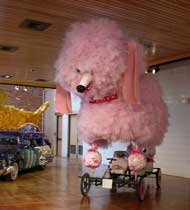
Rouse, known for the planned community of Columbia, MD, apparently was an open-minded businessman whose humane vision, among other things, allowed him to cancel a new development he was planning after he learned that the site was the last mating grounds for the American woodcock. He apparently stayed up all night at the site with a biologist friend watching the birds’ mating dance and was transported in this thinking. More on Rouse here.
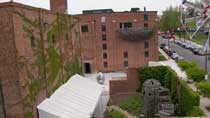
The Rouse Center, one of two barn-like red brick buildings next to AVAM, houses classrooms and banquet facilities upstairs and downstairs and the “Visionary Village” which includes “Fifi” and other large kinetic sculptures from the annual Kinetic Sculpture Race (sponsored by AVAM and now in its third year, I believe — See AVAM’s website for pictures). (image is the Rouse Center in the background and another equally huge red brick building used by AVAM for parties and for large sculptures.)
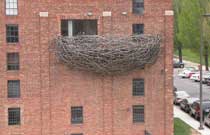
The AVAM campus includes a wildflower garden, a hand-carved wedding chapel which you can see peeking up in the lower right side of the picture above. Barry said the wood was from his backyard and that he helped gather it.
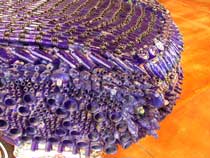
Everything at AVAM has a touch of Baltimore in it. This is one of the things I loved about the museum. It seems completely enamored of Baltimore lore and people. Thus, the large “Bromo Seltzer” car — encrusted with the famous blue glass bottles, refers to Baltimore’s lineage as the town where Bromo Seltzer was made, Barry told me. (image above is a closeup of the Bird’s Nest by David Hess on the Rouse Center, left is a closeup of the Bromo car.)
Another Baltimore idiosyncracy is the painted window screen, and the Rouse Center contains a re-creation of Baltimore row houses with stoops and painted screens. (below)
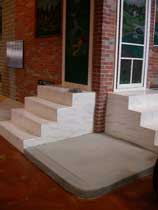
The tradition of painting screens that goes back to 1913 when a grocer, William Oktaver painted a scrren for his corner store and started a hot trend. For more info, contact the Painted Screen Society at paintedscreens@verizon.net. The Society has posters of the screens ($10) and a videoDVD on how to DIY ($25).
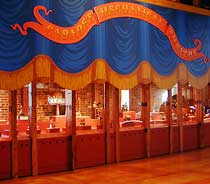
And for those who love push-button exhibits of motorized gizmos, there’s the Cabaret Mechanical Theatre (CMT), (pictured) a group of small-scale kinetic sculptures with wings that flap, people whose heads get lopped off, and all manner of Rube Goldbergian delights. CMT began in England and was at Covent Garden once upon a time. The CMT will be in residence at AVAM until December 2006.
Main Building
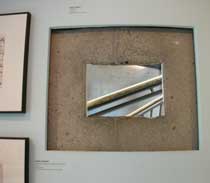
AVAM’s main building is an architectural retrofitting of an old industrial building carved into great gallery spaces, with big windows and a majestic open spiral staircase. Here’s a shot (right) of a window cut out of a wall inside the building. I love the abstract “picture” it creates looking out into the hallway. Visionary sculptor David Hess made the ballustrade for the staircase and also the large Birds Nest balcony on the Rouse Center and the gates to the garden.
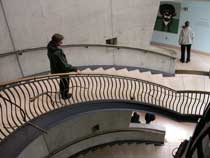
(image is Barry descending the open staircase)
I’m leaving perhaps the most prominent outdoor landmark of AVAM for last — the 55-ft. tall wind-powered Whirlygig in the plaza outside the main building. Created by 76-year old visionary artist and mechanic/farmer Vollis Simpson, the piece spins in the constant harbor breeze and acts like a magnet drawing people to it. (pictured from the second floor balcony, the Whirlygig (image below) seems to be made of scrap metal– I recognized some tin cans. Barry said Simpson had an entire field full of Whirlygigs on his farm. I like the thought of that a lot better than the giant windmills I’ve seen which give me the creeps. )

Hoffberger’s vision and energy put this sprawling, ambitious, exuberant package together and I can’t wait to see it again. “Most museums are fortresses,” Hoffberger said. “We made a decision to make it a welcoming campus.” They’ll be planting giant sunflowers along the Key Highway side of the campus she said — a little bit of the country in the city.
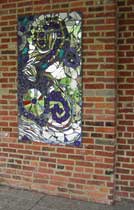
By the way, one reason to re-visit AVAM is that the theme shows change every year. We were lucky enough to see the “Holy H20” show and the breathtaking and heart-wrenching Esther Nisenthal Krinitz Holocaust embroideries. Next year’s show, which will open in the fall, I believe, deals with character. “We tackle themes that have bedeviled mankind,” said Hoffberger. I love that big ambition. Only a visionary could think it.
(image, in a picture taken by Libby, is a mirrored mosaic on the outside of the main building. Hoffberger said they worked with students from a local school and hope to be able to cover the entire building with mirrored mosaic.)









